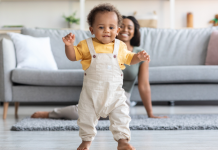

Pssst… parents of the Big Kids (and the Almost Big Kids), this is for you.
You survived infancy. Toddlerhood threw all it had at you. Tying shoes? Riding two-wheelers? Learning to read? Check, check, and check, thank you very much.
You are the parents of REAL in-betweeners. Your kids are between 8 and 10. You’ve witnessed a handful of smooth parenting stages, and you’re starting to believe that you’re going to get out of this. Alive.
But guess what? Your kids’ bodies are plotting against you. Against them. Against EVERYTHING. They are waging wars inside that you can’t even see.
Yup, that’s right.
Puberty.

But wait! Your kids are young and sweet. They still sleep with stuffed animals. You don’t have to worry about THAT yet … right?
You see it, you’re just in denial. Those cute little Big Kids are moo-dy. The other night, you witnessed tears, and doors were slammed (well, a door was slammed, more than once, because the first two slams weren’t dramatic enough) only to find your Big Kid, five minutes later, wondering why you’re looking at them like that.
When Should You Have The Talks?
Around fourth grade, you’ll get a school letter announcing that the PE teachers (you know, the ones who don’t get paid nearly enough?) are going to corral a bunch of prepubescent Big Kids in a room with videos, and giggles… so many giggles. And the anonymous questions? Your kids will ask them, and those PE teachers will answer.
In the note, you’ll see the topics covered so you can talk to your kids ahead of time. If you wait until then to start talking, you’ve waited too long. Some girls have already gotten their periods by the time PE teachers have their talks.
The time to talk to kids is actually years before puberty hits. Because it does hit, full force, with hormones and emotions. The earlier you start having the talks, the longer kids have to get used to the idea.

Have you thought, “If my kids act like this NOW, what is PUBERTY going to be like???” There’s a reason. Because puberty hits the Big Kids, even if you can’t see it. Brains start producing hormones as young as 8. And, like those amusement park rides where you spin in the dark, randomly shooting lasers at the bad guys, hormones have lasers. You never know what will set them off or when they’ll hit the bullseye, but they are twirling and firing from your kids’ brains, sometimes years before you even knew puberty was there.
Be the place your kids go with questions. If they don’t feel comfortable asking you, they may take their questions to Google, and get a whole lot more than they bargained for.
Prepare your kids. Make them comfortable with words like testicles, periods, erections, and pubic hair. Explain what’s going to happen so there are no surprises. Dads? Be comfortable talking with your daughters. Moms? The same with your sons. Have these conversations out in the open, not whispered behind closed doors.
You may be nervous about saying the wrong thing. One PE teacher was asked how long girls have their periods. Her answer? “Possibly into your 50’s.” at which point the room broke out in an uproar, “WHAT?!?” I guess 3 to 7 days would have been a better answer. I’ve talked to my daughter since she was about five, and it comes up often. However, it wasn’t until age 10 that I mentioned periods were a monthly thing. She cried. She assumed it was one and done. And I thought I was covering it all.
What do you need to cover? That’s a fair question. We’ve all been through puberty, but there are things we may have forgotten, and many of us didn’t have an open dialog with our parents about our bodies. We all need a refresher course.
Girls and Puberty
Girls need to know their bodies will change. Their hips and breasts will grow. Some may need training bras as young as third grade. According to our pediatrician, it’s not uncommon for one breast to grow faster than the other. Girls will start to grow pubic hair, underarm hair, and more noticeable hair on their legs. These all lead up to the star of the show: their period. But remember, girls can also get a mucous-like discharge well before their periods start. Give them a head’s up.
American Girl has a collection of books for Big Kids that help kickstart many of these conversations. In addition, there are many other resources. If you haven’t heard about the Dove Self-Esteem project, it is a powerful tool encouraging an ongoing dialog between parents and girls.
Also according to our pediatrician, young girls who start their periods can use tampons, which is especially helpful if your daughter is involved in an activity such as swim team or gymnastics.
For parents who aren’t comfortable with tampons for their girls, they now make underwear (and swim bottoms) that absorb the menstrual flow, with many different options available.
Once your daughter shows signs of puberty beginning, make a cute little bag for her backpack. Inside, pack spare underwear (whether leakproof or regular), pads, a mini pack of hand wipes so they can clean up if necessary, and a plastic bag in case they have stained clothing. If the zippered pouch is big enough, roll up a spare pair of shorts or leggings. This way, if her period begins at school, she is prepared. Remind her that the nurse also has supplies in case she is caught unprepared.
Boys and Puberty
How about boys? Their testicles and penises will grow and be accompanied by pubic hair. They will get hair in other places such as under their arms and on their faces, and they will hesitate before opening their mouths because they can’t trust their voices not to crack. And wet dreams and erections? Start getting comfortable talking about them.
Both boys and girls may start to get acne, will sweat more and smell (hello, deodorant!), and will get taller. Be sure to talk to your sons about the changes that girls go through, and vice versa.

These changes can mess with your kids’ self-confidence. Hormones continue to shoot it out throughout the teen years, and its ammunition is self-doubt, tears, rage, and confusion. Body image is bruised and battered. There are enough questions as these stages roll in, answer as many of them as possible before they are asked.
Something to note: I talked to one PE teacher who said that the information given to boys is lacking. The basics are covered, but remember boys experience a hormone rush that affects their emotions. They, too, feel as though they are spinning out of control.
Boys feel self-conscious about their body changes, too. Mood swings are real. And peer pressure and sex are topics only touched upon during Health class. Do your son, and yourself, a favor and check out some of the puberty books for boys which candidly (and sometimes, humorously) explain what to expect.
One more thing, parents— there is a ridiculously fine line between talking openly with your kids and respecting their privacy as they go through it. We get to figure out how to walk it. Yay, us!
*****
Oh, and those PE teachers? Think of them fondly when Teacher Appreciation week comes around. They’ve more than earned those sweets, treats, and gift cards.












